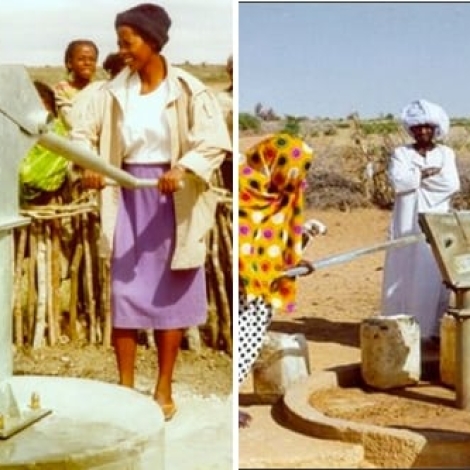The India Mark II is the go-to handpump model in the landlocked southern African country of Zambia, but it’s not clear how that pump became so popular. It doesn’t handle corrosive water as well as another design, the Afridev pump. Afridev was developed in neighboring Malawi and it’s better suited to some of the regional conditions. Afridev pumps top a smattering of Zambian wells, too, and many of those are newer installations made in spite of national resistance to anything but the India Mark II. So, why is the Mark II so popular? One story has it that a program officer from a long-ago pump-building boom simply liked the Mark II because it worked in India, and the pump caught on. Since then, the government ministry that oversees pump standardization has issued confusing recommendations for both pump models. It even wrote a memo describing the circumstances in which to install an Afridev that were the exact opposite of guidelines contractors were using in the region.
Jess MacArthur, a Water Sanitation and Hygiene Technical Advisor for iDE in Bangladesh, recounts this Zambian conundrum in an overview on pump standardization published in 2015 by the Rural Water Supply Network (pdf). Twenty out of the 35 sub-Saharan African countries don’t have formal pump standardization policies, and Zambia is one of them.
“I think it would be helpful to have more structure to the wild wild west of rural water-point installation” – Susan Davis, Improve International
More than 180 million people out of the 930 million in sub-Saharan Africa depend on handpumps for water. There are nearly 1 million installed now and 60,000 more are added every year, MacArthur reports. Handpumps in this case refer to any human-powered pump, including pedal-powered pumps.
Zambia’s loose recommendations and possibly unexamined preference for a certain model of pump exemplifies one of the downsides of informal handpump standardization. Standardizing a region’s pumps can improve the supply of spare parts and the availability of people who know how to fix and operate the machine. A good policy can also dictate the best model of pump for different regional conditions.
“Based on many of the reports and evaluations I’ve read, I think it would be helpful to have more structure to the wild wild west of rural water-point installation,” Susan Davis, who heads the international water and sanitation consultation firm Improve International, told E4C.
“In many countries, as this report mentions, organizations operate independently of each other and the government, and ignorant of contextual settings. 40 percent of surveyed organizations [in the report] didn’t know about standards,” Davis says.
MacArthur argues that countries that rely heavily on handpumps should consider adopting a policy of standardization. That said, strict rules can stifle innovation, and any country-wide policy should account for new technology that improves on what we have today.
The Technology Applicability Framework tool evaluates the suitability of existing pumps and new designs proposed for endorsement.
One way to create a policy that has room for mysterious future invention is to charge the government with endorsing pump models. If the tactic works smoothly, proven designs will proliferate and new designs can go up for testing with the potential for endorsement.
Or, as Davis says, “Maybe, to think ‘outside the pump,’ governments could encourage organizations who facilitate sustained basic or above water service levels to continue or scale up work in their country. And the alternative, [government could] ask organizations who cannot demonstrate this ability to stop working there, or step up their games. This would allow more flexibility and innovation in technology, approaches to installation and service delivery, financing, etc.”
Engineers should work with policy makers to examine the research, conduct tests and identify the right pumps to use. And there is help. The Technology Applicability Framework is a tool that can help evaluate the suitability of existing pumps and new designs proposed for endorsement.
There’s one more thing to consider in the push for standardization, Davis says. While technology guidelines that are based on performance, not on someone’s opinion or a good marketing campaign, are helpful, installing the pump is not the end of the story.
“There is so much more to lasting services than the handpump, and much of it has to do with what happens after the pump is installed,” Davis says.
Read the report: Handpump Standardisation in Sub-Saharan Africa: Seeking a champion

